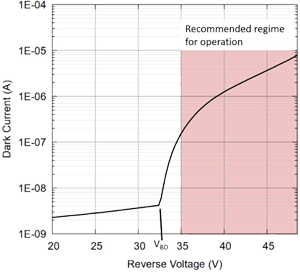Broadcom's SiPM data sheets detail key performance parameters of their silicon photomultipliers including the Breakdown Voltage which is explained in more detail below.

SiPMs exhibit a sudden rise in Dark Current at the breakdown voltage as current density increases rapidly due to thermally generated electrons, which trigger the discharge of SPADs. For Broadcom's latest NUV-MT technology with 40µm SPAD pitch the current density approaching breakdown is typically 25nA/cm² and is dominated by carrier diffusion and generation.
The lower limit for the applied Bias Voltage is theoretically the Breakdown Voltage - for the latest NUV-MT SiPMs this is 32.5±0.5V (25°C).
However, the ideal minimum voltage for stable operation is the point at which the Dark Current starts to flatten in the IV curve. The figure to the right shows the IV curve for a single channel of the AFBR-S4N44P164M (4x4 array, 4mm pitch) and highlights the recommended operating regime with Overbias ≥2.5V.
All SiPM characteristics change with Overbias - Photon Detection Efficiency, Gain, Dark Count Rate, Dark Current and Crosstalk - all of which affect the performance of the SiPM in any given application. Most NUV-MT data sheet specifications are at 12V Overbias and users typically operate in the 7V to 12V range.
Broadcom's tightly controlled wafer fabrication processes result in excellent breakdown voltage uniformity with only a small spread of ±500mV. It is therefore possible to power all SiPMs using the same bias voltage whilst also achieving acceptable uniformity. This attribute is equally beneficial regardless of whether a customer is using many individual SiPMs or large arrays as it allows a single bias voltage, reduced system design complexity and reduced cost.
However, SiPMs have a positive temperature coefficient of the breakdown voltage. The value of this temperature coefficient depends in a first approximation on the depth of the avalanche zone and is typically 30mV/°C for Broadcom NUV-MT SiPMs.
This attribute means that if a fixed Bias Voltage is applied then the Overbias and associated specifications vary with temperature and users may need to adopt strategies to stabilise the Overbias using the 30mV/°C coefficient.
For more information on Temperature Effects refer to the links on the right hand side of this page. Additional information on Bias Voltage can be found in these Application Notes:-
| Product Brief, NUV-MT SiPM range | |
| A Brief Introduction to SiPMs | |
| Working with Broadcom SiPMs |
For more detail please visit the Support pages using the links in this article and on the right hand side of this page.


